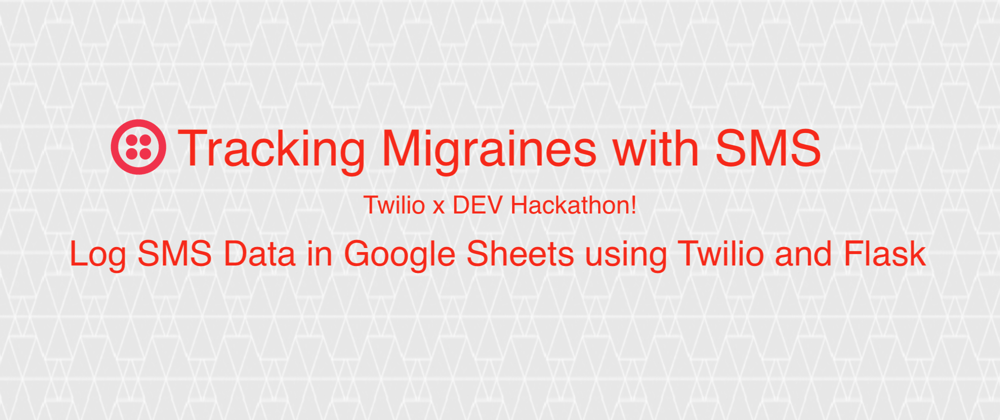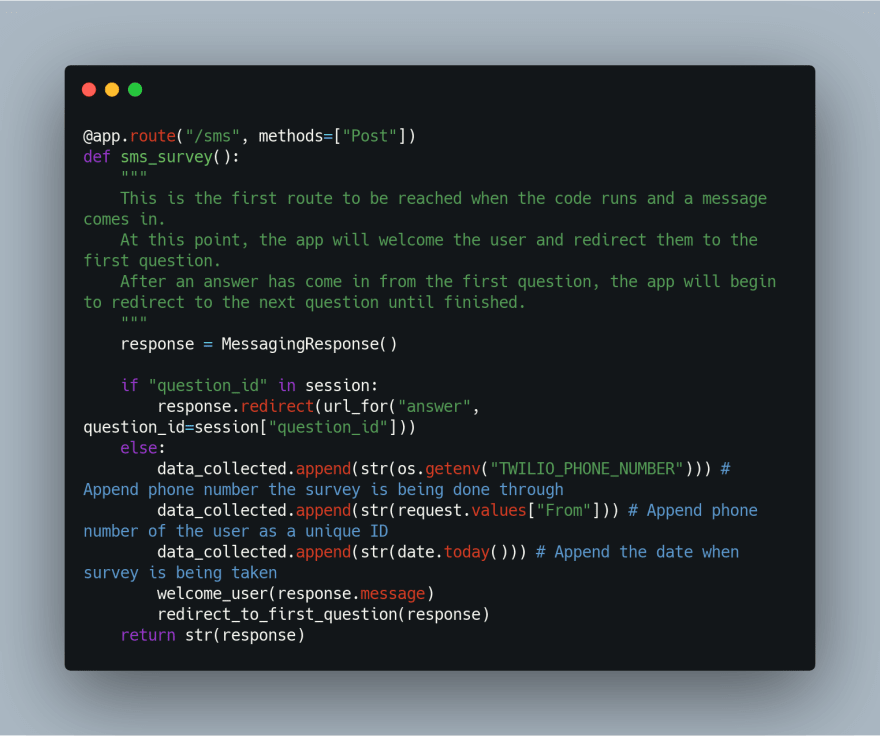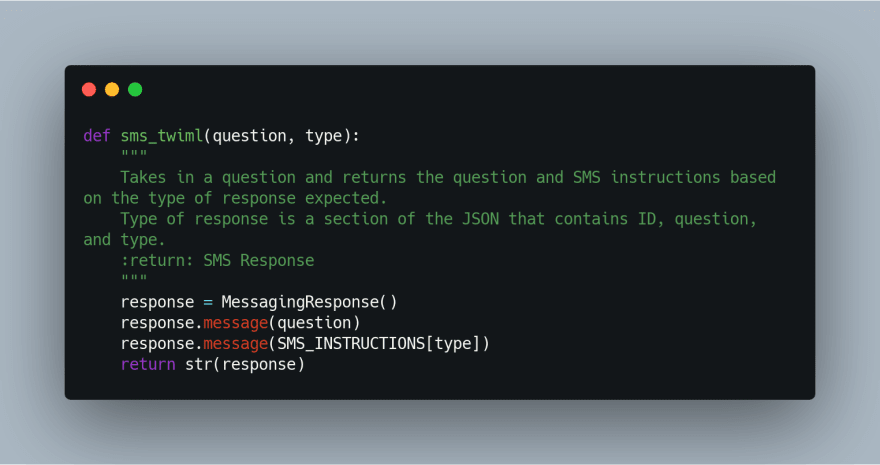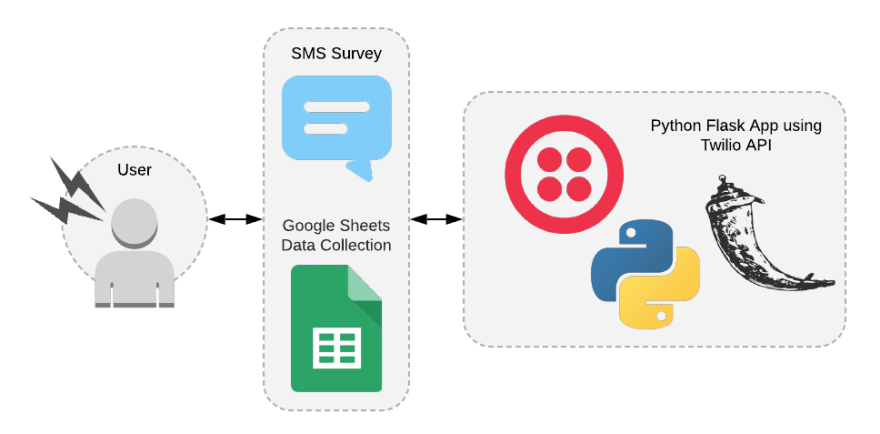Happy Wednesday evening and last day of the Twilio x Dev Hackathon! I hope you are all doing well. It has been great to spend the month of April working with Twilio and Google sheets on this project in order to capture SMS data from a survey.
For those who may not have seen the other posts in this series, you can view them above. The first post began as the initial start of the project in Tracking Migraines with SMS which is just an introductory post.
The setup of Google Sheets is discussed in Setting up Python to Connect to Google Sheets where I talked about API Errors due to scope along with path issues with PyTest.
My first experience with Flask is talked about in the post What I Learned using Flask for the First Time in which I discussed port issues, data types, casting data types, and Flask sessions. This section also details issues with getting to the next question in the survey.
The final integration of Google Sheets and Twilio is discussed in Integrating Twilio with Google Sheets. This post discusses clearing results in a list, and data import issues with Google Sheets appending single quotes at the start of numbers and dates.
With all of that said, todays post will focus on the wrap up of the Twilio x Dev Hackathon, along with a walk through and discussion of the application flow through the functions in app.py.
Quick Recap
For a quick recap on the project concept, I spend time logging migraines for the doctors office but don't remember the format she wanted, or the details she found important. This application was created as a way to request a survey for a migraine, quickly fill out the details, and log the data for later use at the doctors appointment.
Commonly Asked Questions for Migraines
Below is a list of commonly asked questions relating to migraines:
- In a scale of 1-10, how would you rate your migraine?
- Where is your migraine located today?
- How long did your migraine last (in hours)?
- What medication did you take to treat the migraine?
- Has anything changed? Is anything out of the ordinary? Do you have any other notes to add?
Category - Engaging Engagements and Interesting Integrations
During this hackathon, I focused on two categories: Engaging Engagements and Interesting Integrations.
Engaging Engagements looked at developing applications that a company could implement to better engage with their customers or to manage their business. An application of this type could be utilized by doctors offices in order to collect data commonly needed during patient visits or to have patients collect their own data for use in their visits.
Interesting Integrations focused on the integration of the Twilio API with at least one other API. This application integrated Twilio with the Google Sheets API in order to log data in an easy to access format.
Filled out Twilio CodeExchange Agreement: ✔️
Agreed to the Competition's Terms: ✔️
Link to Code
To clone the code, please visit the GitHub project Migraine Tracking.
Demo Link
In the repository is also a GIF showing a brief demo of the code. There is also a README available for those who would like to run the code locally and try it out.
Application Flow
The first route that is reached when the application receives an SMS is the /sms route that calls the function sms_survey(). This function looks to see if a question ID comes in and in the session, the function will redirect to the /answer route.
Before a question ID will come in, the function will first default to collecting the Twilio number, the users number, and the date. Note: These were hidden in the demo data output in Google Sheets. These values are appended to the collected data list and then the a welcome message will be displayed to the user through the welcome_user() function. After displaying the welcome message, the user is redirected to the first question in the survey.
welcome_user(), seen below, will return a brief message to the user. Then the user is directed to the /question/<question_id> route.
The /question/<question_id> route takes in the question ID and tells the application which question it should respond back to the user with. Using the question ID, we pass the ID into the parseJson pulls out the first question and its type. The question ID is stored into a session variable called question_id to be used as the application looks for the next question or the end of the survey. Once that has been captured, the sms_twiml() function is called with question and type.
This function responds with the message and type of data to ask the user for. The three types of data asked for in this survey are text, hours, or a numeric number from 1 to 10.
After the user has answered the question, the application will redirect to the /answer/<question_id> route. This route first iterates to the next question ID which is used to grab data collected from the parseJson object. Then, the user entered data for the previous question is extracted and appended to the data_collected list. extract_content() returns either text for text elements or numeric digits for hours and numeric answers. If data is available for the next question, the survey will continue by redirecting to the /question/<question_id> route, otherwise the survey will end and display a goodbye message through the use of the goodbye_twiml() function.
The redirect_twiml() redirects the survey to the /question/<question_id> route to allow the user to view and answer the next question, repeating the process until all questions have been answered.
The goodbye_twiml() function ends the survey, appending all the data collected into the Google Sheet using the spreadsheet object. After a goodbye message is displayed to the user, the data collected is cleared from the data_collected list and the session variable for question_id is cleared.
And that is the overall flow of the code from first question to last.
Development Stack
Thank you for following along this past month as all of the pieces have come together to log the data into the Google sheet from the SMS survey.
Thank you to all those who put together this hackathon and participated in it. Have a Happy May!
Additional Resources
Reference Links
Twilio's Rest API
Automated Survey - Python Flask App
GitHub Sample Automated Survey
Google Sheets and Python Example
Accessing Google Spreadsheets with Python















Oldest comments (0)